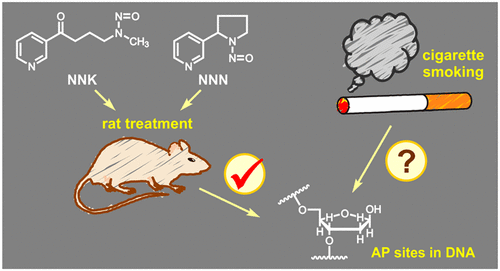当前位置:
X-MOL 学术
›
Chem. Res. Toxicol.
›
论文详情
Our official English website, www.x-mol.net, welcomes your
feedback! (Note: you will need to create a separate account there.)
Mass Spectrometric Quantitation of Apurinic/Apyrimidinic Sites in Tissue DNA of Rats Exposed to Tobacco-Specific Nitrosamines and in Lung and Leukocyte DNA of Cigarette Smokers and Nonsmokers.
Chemical Research in Toxicology ( IF 3.7 ) Pub Date : 2020-08-24 , DOI: 10.1021/acs.chemrestox.0c00265 Jiehong Guo 1 , Haoqing Chen 1 , Pramod Upadhyaya 1 , Yingchun Zhao 1 , Robert J Turesky 1 , Stephen S Hecht 1
Chemical Research in Toxicology ( IF 3.7 ) Pub Date : 2020-08-24 , DOI: 10.1021/acs.chemrestox.0c00265 Jiehong Guo 1 , Haoqing Chen 1 , Pramod Upadhyaya 1 , Yingchun Zhao 1 , Robert J Turesky 1 , Stephen S Hecht 1
Affiliation

|
Metabolic activation of the carcinogenic tobacco-specific nitrosamines 4-(methylnitrosamino)-1-(3-pyridyl)-1-butanone (NNK) and N′-nitrosonornicotine (NNN) results in formation of reactive electrophiles that modify DNA to produce a variety of products including methyl, 4-(3-pyridyl)-4-oxobutyl (POB)-, and 4-(3-pyridyl)-4-hydroxybutyl adducts. Among these are adducts such as 7-POB-deoxyguanosine (N7POBdG) which can lead to apurinic/apyrimidinic (AP) sites by facile hydrolysis of the base-deoxyribonucleoside bond. In this study, we used a recently developed highly sensitive mass spectrometric method to quantitate AP sites by derivatization with O-(pyridin-3-yl-methyl)hydroxylamine (PMOA) (detection limit, 2 AP sites per 108 nucleotides). AP sites were quantified in DNA isolated from tissues of rats treated with NNN and NNK and from human lung tissue and leukocytes of cigarette smokers and nonsmokers. Rats treated with 5 or 21 mg/kg bw NNK for 4 days by s.c. injection had 2–6 and 2–17 times more AP sites than controls in liver and lung DNA (p < 0.05). Increases in AP sites were also found in liver DNA of rats exposed for 10 and 30 weeks (p < 0.05) but not for 50 and 70 weeks to 5 ppm of NNK in their drinking water. Levels of N7POBG were significantly correlated with AP sites in rats treated with NNK. In rats treated with 14 ppm (S)-NNN in their drinking water for 10 weeks, increased AP site formation compared to controls was observed in oral and nasal respiratory mucosa DNA (p < 0.05). No significant increase in AP sites was found in human lung and leukocyte DNA of cigarette smokers compared to nonsmokers, although AP sites in leukocyte DNA were significantly correlated with urinary levels of the NNK metabolite 4-(methylnitrosamino)-1-(3-pyridyl)-1-butanol (NNAL). This is the first study to use mass spectrometry based methods to examine AP site formation by carcinogenic tobacco-specific nitrosamines in laboratory animals and to evaluate AP sites in DNA of smokers and nonsmokers.
中文翻译:

对暴露于烟草特异性亚硝胺的大鼠组织 DNA 以及吸烟者和不吸烟者的肺和白细胞 DNA 中的无嘌呤/无嘧啶位点进行质谱定量。
致癌烟草特有的亚硝胺 4-(甲基亚硝胺)-1-(3-吡啶基)-1-丁酮 (NNK) 和N'-亚硝基降烟碱 (NNN) 的代谢激活会导致形成反应性亲电子试剂,从而修饰 DNA 产生多种产品包括甲基、4-(3-吡啶基)-4-氧代丁基(POB)-和4-(3-吡啶基)-4-羟丁基加合物。其中包括加合物,例如 7-POB-脱氧鸟苷 (N 7 POBdG),它可以通过碱基-脱氧核糖核苷键的轻松水解产生无嘌呤/无嘧啶 (AP) 位点。在本研究中,我们使用最近开发的高灵敏度质谱方法通过O -(吡啶-3-基-甲基)羟胺 (PMOA) 衍生化来定量 AP 位点(检测限,每 10 8 个核苷酸 2 个 AP 位点)。对从接受 NNN 和 NNK 治疗的大鼠组织以及吸烟者和不吸烟者的人肺组织和白细胞中分离的 DNA 中的 AP 位点进行了定量。通过皮下注射 5 或 21 mg/kg bw NNK 治疗 4 天的大鼠,其肝脏和肺 DNA 中的 AP 位点比对照组多 2-6 倍和 2-17 倍( p < 0.05)。在饮用水中暴露 5 ppm NNK 10 周和 30 周( p < 0.05)但暴露 50 周和 70 周的大鼠的肝脏 DNA 中也发现 AP 位点增加。在用 NNK 治疗的大鼠中,N 7 POBG 水平与 AP 位点显着相关。在大鼠的饮用水中加入 14 ppm ( S )-NNN 治疗 10 周后,与对照组相比,在口腔和鼻腔呼吸道粘膜 DNA 中观察到 AP 位点形成增加 ( p < 0.05)。 与不吸烟者相比,吸烟者的人肺和白细胞 DNA 中的 AP 位点没有显着增加,尽管白细胞 DNA 中的 AP 位点与 NNK 代谢物 4-(甲基亚硝基氨基)-1-(3-吡啶基) 的尿液水平显着相关-1-丁醇(NNAL)。这是第一项使用基于质谱的方法来检查实验动物中致癌烟草特异性亚硝胺形成的 AP 位点并评估吸烟者和非吸烟者 DNA 中的 AP 位点的研究。
更新日期:2020-09-21
中文翻译:

对暴露于烟草特异性亚硝胺的大鼠组织 DNA 以及吸烟者和不吸烟者的肺和白细胞 DNA 中的无嘌呤/无嘧啶位点进行质谱定量。
致癌烟草特有的亚硝胺 4-(甲基亚硝胺)-1-(3-吡啶基)-1-丁酮 (NNK) 和N'-亚硝基降烟碱 (NNN) 的代谢激活会导致形成反应性亲电子试剂,从而修饰 DNA 产生多种产品包括甲基、4-(3-吡啶基)-4-氧代丁基(POB)-和4-(3-吡啶基)-4-羟丁基加合物。其中包括加合物,例如 7-POB-脱氧鸟苷 (N 7 POBdG),它可以通过碱基-脱氧核糖核苷键的轻松水解产生无嘌呤/无嘧啶 (AP) 位点。在本研究中,我们使用最近开发的高灵敏度质谱方法通过O -(吡啶-3-基-甲基)羟胺 (PMOA) 衍生化来定量 AP 位点(检测限,每 10 8 个核苷酸 2 个 AP 位点)。对从接受 NNN 和 NNK 治疗的大鼠组织以及吸烟者和不吸烟者的人肺组织和白细胞中分离的 DNA 中的 AP 位点进行了定量。通过皮下注射 5 或 21 mg/kg bw NNK 治疗 4 天的大鼠,其肝脏和肺 DNA 中的 AP 位点比对照组多 2-6 倍和 2-17 倍( p < 0.05)。在饮用水中暴露 5 ppm NNK 10 周和 30 周( p < 0.05)但暴露 50 周和 70 周的大鼠的肝脏 DNA 中也发现 AP 位点增加。在用 NNK 治疗的大鼠中,N 7 POBG 水平与 AP 位点显着相关。在大鼠的饮用水中加入 14 ppm ( S )-NNN 治疗 10 周后,与对照组相比,在口腔和鼻腔呼吸道粘膜 DNA 中观察到 AP 位点形成增加 ( p < 0.05)。 与不吸烟者相比,吸烟者的人肺和白细胞 DNA 中的 AP 位点没有显着增加,尽管白细胞 DNA 中的 AP 位点与 NNK 代谢物 4-(甲基亚硝基氨基)-1-(3-吡啶基) 的尿液水平显着相关-1-丁醇(NNAL)。这是第一项使用基于质谱的方法来检查实验动物中致癌烟草特异性亚硝胺形成的 AP 位点并评估吸烟者和非吸烟者 DNA 中的 AP 位点的研究。











































 京公网安备 11010802027423号
京公网安备 11010802027423号